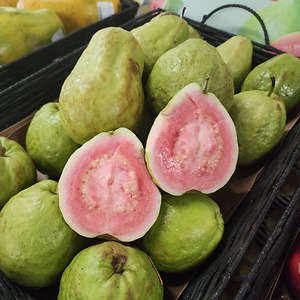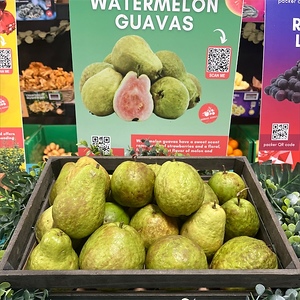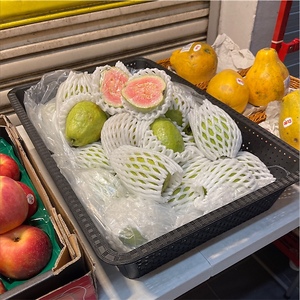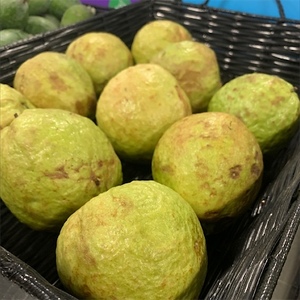


Watermelon Guavas
Estimated Inventory, lb : 0
This item was last sold on : 08/11/24
Description/Taste
Watermelon guavas are oval to pear-shaped fruits with a moderate size, averaging 5 to 7 centimeters in diameter. The semi-rough skin is green, leathery, and slightly bumpy, and underneath the thin skin, the red-pink flesh is dense and crisp. The flesh is also known for having a firm, granular, and crunchy, apple-like consistency, encasing many small, hard, and edible, yellow seeds. Watermelon guavas have a sweet scent reminiscent of strawberries and a floral, fruity, and sweet flavor of melon and berries.
Seasons/Availability
Watermelon guavas are available in the summer through early winter in tropical regions around the world. Depending on the climate and location, some regions may be able to produce fruit year-round.
Current Facts
Watermelon guavas, botanically classified as Psidium guajava, are a variety of pink guava that belongs to the Myrtaceae family. The sweet, subtly tart fruits have a firmer flesh than other pink guava varieties and are known for their floral, strawberry flavor. Watermelon guavas are a specialty variety that is not commercially cultivated on a wide scale. Despite their rarity, the variety can be found through small fruit growers in Taiwan, Florida, and the Caribbean and are favored for fresh eating and processing.
Nutritional Value
Watermelon guavas are an excellent source of vitamins A and C, which are antioxidants that assist in maintaining healthy organ functioning and can help strengthen the immune system. The fruits also provide fiber, which stimulates digestion, and some omega-3 fatty acids, potassium, and folate.
Applications
Watermelon guavas are best suited for both raw and cooked applications, such as boiling. When fresh, the fruits can be eaten similarly to an apple with the skin on, or it can be sliced into quarters and sprinkled with sugar or salt for added flavor. The flesh can also be blended into smoothies, juiced and mixed into fruit punches, or stirred into cocktails. In addition to fresh applications, Watermelon guavas can be cooked into sauces and poured over roasted meats, boiled into jellies, jams, and syrups, used to flavor cakes, muffins, danishes, and ice cream, or dried and steeped as a tea. The sweet-tart fruits can also be pickled for extended use. Watermelon guavas pair well with meats such as poultry, beef, and pork, shrimp, garlic, ginger, fruits such as strawberries, coconuts, bananas, mangos, and pineapples, and cheeses such as manchego, goat, and feta. Whole Watermelon guavas can be stored for 1-3 days at room temperature or 7-15 days in the refrigerator. Once ripe, it is recommended to consume immediately for the best texture and flavor.
Ethnic/Cultural Info
In Florida, guava jelly production was once known as one of the booming industries for the state and was also considered a staple ingredient in home kitchens. Many of the guava varieties found in Florida were introduced from Cuba, and the tropical trees grew rampant throughout backyards, in city parks, and along roadsides. With an excess of fresh fruits, manufacturers developed guava jelly in the early 20th century as a long-lasting, tropical souvenir for tourists. Guava jelly also grew in popularity among the locals, who commonly spread it on toast, over pastries, and on top of ice cream. Historians recount that over two dozen guava jelly companies were competing for business throughout Florida during the 20th century. In the modern-day, the Florida guava jelly industry has slowly disappeared, leading the sweet-tart condiment to be found through farmer’s markets, small companies, and home chefs.
Geography/History
Watermelon guavas are a variety of pink guava, which were originally native to a region spanning from southern Mexico to Central America. In the 15th and 16th centuries, Pink guavas were then spread to Southeast Asia, the Caribbean, and the South Pacific through Portuguese and Spanish explorers, and were later introduced to Florida in 1847. Today Watermelon guavas are found throughout tropical regions around the world and are primarily grown through specialty growers or in home gardens. The Watermelon guavas featured in the photograph above were grown through Miami Fruit in Florida.











